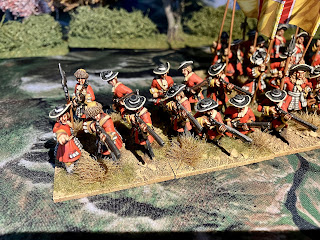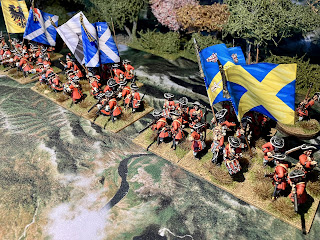Way back in part 3 of this occasional series I covered a little of the history of the Battle of Killiecrankie, 1689 and showed off the Jacobite forces I have for the battle. Now it’s the turn of the government army to enter the limelight.
The right flank contained the only English troops, Hastings’ regiment of foot along with Weem’s highland company. In Black Powder Pike & Shotte terms the former is a large unit whist the latter is a tiny unit (Pike & Shotte doesn’t actually include tiny units, but it’s simple enough to include them).
Being at the rear of the column of march, possibly charged with escorting the baggage, Hastings’ English infantry ended up holding what is usually the senior position in the line as the Jacobite army formed to the right of the line of march. A fine body of men! Front Rank miniatures painted by Steve Shann and waving Warfare Miniatures flags. All figures Front Rank painted by Steve unless I say otherwise. Saves me repeating myself!
I’ve seen one modern line drawing of a grenadier of Hastings’ regiment in a continental fur cap. I liked it so went with that look for the grenadiers.
I’ve painted Weem’s highland company and the baggage. The highlanders are Essex (unloved and unwanted in my 1745 collection!) and the baggage are Warlord and Front Rank.
The highlanders were on the extreme right, due either to being told to keep out of the way or having formed a rearguard on the march. The baggage is important to represent in this battle as it distracts many a Jacobite from pursuing the broken government troops.
Next we find the commander in chief Mackay’s regiment. The government centre wasn’t positioned in close mutual support as I’ve photographed them above. Due to terrain and to cover the frontage of the Jacobite army above them, the government centre was stretched thin. A reminder of the dispersed dispositions:
Government army shown bottom in red. The guns were in glorious isolation (well they had the small mounted contingent behind them, which I can represent with figures drawn from other parts of my late 17thc collection) as were Kenmure’s regiment.
Mackay’s regiment. Part of the Scots Brigade in Dutch service.
Leven’s foot. Recently raised, but I’ve allowed that they’ve received redcoats and consequently look quite martial.
The light artillery and Kenmure’s foot. The government army was able to transport leather guns with them. I’ve used a suitable Warlord ECW set to represent the artillery. The piece is crewed by a converted Front Rank gunner, one of the Warlord matrosses and two Front Rank matrosses.
Kenmure’s regiment was even more recently raised than Leven’s. So I’ve shown them in hodden grey, pretty much every day, civilian clothing.
Then on the government left flank we have Balfour and Ramsay’s regiments. These regiments together with Mackay’s formed the Scots Brigade.
On the extreme left, under the command of Lauder, was a composite unit formed from the grenadiers drawn from the three Scots Brigade regiments. Again these sport continental fur caps. A natural choice since these chaps are part of the Dutch army.
To finish with, a couple of shots of the Scots Brigade standing together. The Jacobite army was really no match for these regulars. Well, it shouldn’t have been…
The next instalment of late 17thc wargaming will be another after action report! So watch out for that.
Thanks for reading!
Cheers
Chris


















Lovely Chris, well done.
ReplyDeleteCheers Robbie! It’s quite the collection now
DeleteBeautiful looking units. Marvellous painting and basing (and photography too)!
ReplyDeleteRegards, James
Thanks James. Steve’s done a fine job of painting the majority of this collection. The photography is the easy bit 😉
ReplyDelete